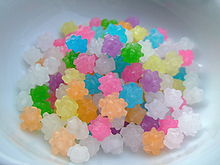- Kompeitō
-
Kompeito, also spelled as konpeito (Japanese: 金平糖, 金米糖, or 金餅糖 in Kanji, or こんぺいとう, コンペイトー in kana, konpeitō) is a Japanese candy.
Contents
History
The word "konpeito" comes from the Portuguese word confeito, which means a sugar candy. This technique for producing candy was introduced to Japan in the early 16th century by Portuguese traders. The infrastructure and refining technology of sugar had not yet been established in Japan in those days. As konpeito uses a lot of sugar, it was very rare and expensive as a result. In 1569, Luís Fróis, a Portuguese missionary, presented a flask of konpeito to Oda Nobunaga in order to obtain the permit for mission work of Christianity.
In Meiji period, konpeito had already been culturally-prescribed as one of the standards of Japanese sweets - the character Sugar Plum Fairy in the Nutcracker was translated into konpeito no sei (Japanese: 金平糖の精, Fairy of konpeito). Konpeito is also the standard of the thank-you-for-coming gift which is given by the Imperial House of Japan. The gift is not called konpeito but pomponiere (Japanese: ポンポニエール, pomponieru) including the top case.
Production
Konpeito is usually 5 to 10 mm (0.20 to 0.39 in) in diameter. Each piece is covered with tiny bulges, which occur in the cooking process. It usually takes 7-10 days to make konpeito and they are handmade even today. Konpeito is made by showering sugar water in a giant spinning tub called dora.
See also
- Wagashi
- Rock candy
- Japanese words from Portuguese
External links
Categories:- Wagashi
- Portuguese loanwords
Wikimedia Foundation. 2010.

